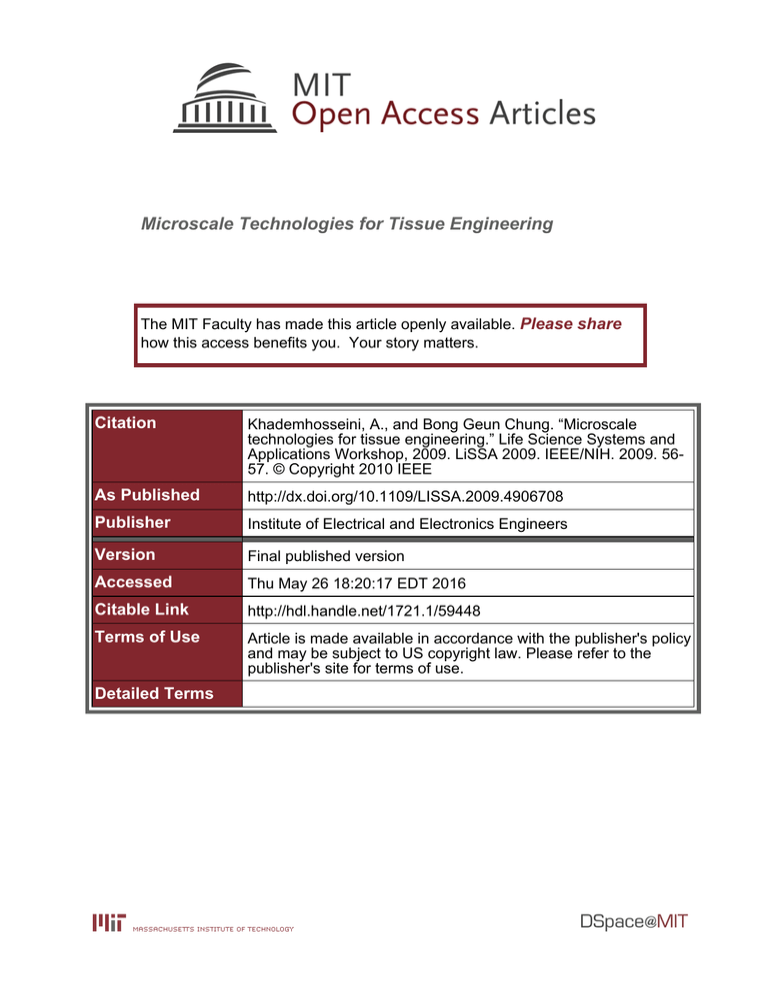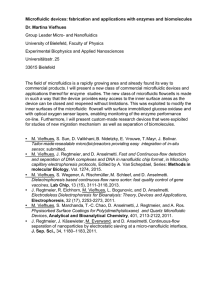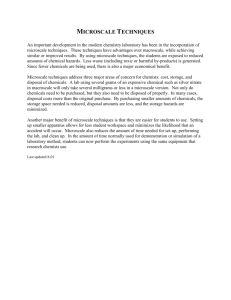Microscale Technologies for Tissue Engineering Please share
advertisement

Microscale Technologies for Tissue Engineering The MIT Faculty has made this article openly available. Please share how this access benefits you. Your story matters. Citation Khademhosseini, A., and Bong Geun Chung. “Microscale technologies for tissue engineering.” Life Science Systems and Applications Workshop, 2009. LiSSA 2009. IEEE/NIH. 2009. 5657. © Copyright 2010 IEEE As Published http://dx.doi.org/10.1109/LISSA.2009.4906708 Publisher Institute of Electrical and Electronics Engineers Version Final published version Accessed Thu May 26 18:20:17 EDT 2016 Citable Link http://hdl.handle.net/1721.1/59448 Terms of Use Article is made available in accordance with the publisher's policy and may be subject to US copyright law. Please refer to the publisher's site for terms of use. Detailed Terms Microscale Technologies for Tissue Engineering en Ali Khademhosseini* Harvard-MIT Division of Health Sciences and Technology, Harvard Medical School, Brigham and Women’s Hospital, MA Bong Geun Chung Harvard-MIT Division of Health Sciences and Technology, Harvard Medical School, Brigham and Women’s Hospital, MA alik@mit.edu bchung2@mit.edu Abstract—Microscale technologies are emerging as enabling tools for tissue engineering and biology. Here, we present our experience in developing microscale technologies to regulate cell-microenvironment interactions and generate engineered tissues. Specifically, we will describe the use of microengineered shape-controlled hydrogels to generate biomimetic 3D tissue architectures, the utility of surface patterning approaches for controlling cell-cell interactions and engineered microchannels for controlling cell-soluble factor interactions. These shear-protective hydrogel microwell arrays enabled stable cell patterning. Furthermore, Poly(ethylene glycol) (PEG) hydrogel microwells have been used to control homogeneous cell aggregates[4, 6]. It was demonstrated that cells cultured within PEG hydrogel microwells remained highly viable, resulting in directed differentiation of stem cells. In addition to microwell arrays, microfabricated parylene-C stencils can be fabricated to reversibly seal on a hydrophobic surface to enable surface patterning[11, 12]. Using this reusable stencil, microscale co-patterns of cells and proteins were generated on substrates. These microfabricated parylene-C stencils were used to pattern co-cultures of cells in static and dynamic conditions. To study cell-cell contact, patterned co-cultures have been fabricated by using layer-by-layer deposition of ionic biopolymers[13]. In this approach, nonbiofouling hyaluronan polymer was used for micropatterning cells and proteins onto substrates. The adhesion of a second cell type was accomplished by switching the cell-repulsive property of the hyaluronan surface by ionic adsorption of positively charged poly-L-lysine (PLL). Using this approach, stem cells and fibroblasts were co-cultured to study cell-cell contacts. These microfabrication-based surface patterning techniques provide a useful approach to manipulate cell-cell interactions for regulating cellular behavior. INTRODUCTION Tissue engineering, is an interdisciplinary research field that aims to generate transplantable tissues that can restore, maintain, and enhance tissue function[1, 2]. However, despite significant advances in tissue engineering, a number of challenges limit the therapeutic applications of tissue engineering approaches. Microscale technologies are enabling tools for addressing the challenges imposed by conventional tissue engineering methods. Microscale technologies enable the control of cell-microenvironment interactions, such as cell-cell, cell-extracellular matrix (ECM), and cell-soluble factor interactions[3]. One such technique is soft lithography. In soft lithography, elastomeric poly(dimethylsiloxane) (PDMS) stamps made from photoresist- patterned silicon masters can be used to manipulate the topography of a surface at sub-micron resolution in a rapid and inexpensive manner. Moreover, microengineering approaches are used to create tissue scaffolds with enhanced physical, mechanical, and biological properties. In this paper, we present various microscale technologies (i.e. surface patterning, microfluidics, microengineered hydrogel arrays) for tissue engineering applications. Surface patterning for regulating cell-cell contacts Microscale surface patterning can be used to control cell-cell contacts and cellular shapes. Various microscale technologies, such as microtopography[4-9], microfabricated stencils[10-12], and layer-by-layer deposition[13], have been used to pattern cells within geometrically defined substrates. For example, hyaluronan modified with photoreactive methacrylates has been used to make microstructures[5]. * This paper was partly supported by the National Institutes of Health (NIH), US Army Core of Engineers, and the Charles Stark Draper Laboratory. c 2009 IEEE 978-1-4244-4293-5/09/$25.00 Microfluidics for spatial control of cell-soluble factor interactions Microfluidic systems are powerful tools for controlling the spatial and temporal aspects of cell-soluble factor interactions. Microfluidic systems have been used to control cell docking[14] and cell-soluble factor interactions. For example, a multiphenotype cell array inside a microfluidic channel was fabricated by reversibly sealing a PDMS mold with the impression of the fluidic channel to a microwell-containing substrate. Cells and fluids were selectively delivered to the microwells. This microfluidic device containing sequentially aligned orthogonal microchannels is a potentially useful approach for the high-throughput experimentation. Microfluidics has also been used to create stable hydrogel gradients and generate cell-laden hydrogel scaffolds. These microfluidic devices can address several challenges associated with current scaffolds, such as the inability to 56 control the complex cellular interactions in the scaffolds and the lack of vascularization. Microfluidic systems can be used to synthesize microengineered scaffolds that can overcome these limitations[15]. To generate hydrogel scaffolds with gradients, materials can be generated with embedded gradients by using a microfluidic device[16]. By creating gradients of adhesive peptides conjugated within hydrogels, the attachment of endothelial cells along the material can be controlled. Microfluidic devices have also been shown as a promising tool to facilitate the exchange of nutrients and oxygen in 3D tissue constructs. We have recently developed cell-laden hydrogel microfluidic channels and demonstrated that (just like in real tissues) only cells near microfluidic channels remained viable after three days in vitro [17]. These cell-laden hydrogel microfluidic devices can be scaled up by stacking the vascular patterns to create biomimetic multi-layer vascularization. Therefore, microfluidic devices are powerful tools for controlling cell-soluble factor interactions and are increasingly used by biologists and tissue engineers to study cell behavior and create tissue constructs. Microengineered hydrogel arrays for tissue engineering Recently the merger of microengineered hydrogels and microscale techniques has been used to develop new approaches to create 3D tissue constructs. We have developed bottom-up tissue engineering technique that use directed assembly of hydrogels. In this approach, tissue-mimetic building blocks are generated and subsequently assembled to create larger structures. The shape of the individual pieces can be controlled to enable their assembly by using directed self-assembly[18, 19] or stop-flow lithography in a microfluidic device[20]. Therefore, the modular design and assembly of these approaches can influence many areas of tissue engineering. CONCLUSIONS [6] H.C. Moeller, M.K. Mian, S. Shrivastava and B.G. Chung, A. Khademhosseini, A microwell array system for stem cell culture, Biomaterials, vol. 29, 2008, pp. 752-763. [7] J.C. Mohr, J.J. de Pablo and S.P. Palecek, 3-D microwell culture of human embryonic stem cells, Biomaterials, vol. 27, 2006, pp. 6032-6042. [8] A. Rosenthal, A. Macdonald and J. Voldman, Cell patterning chip for controlling the stem cell microenvironment, Biomaterials, vol. 28, 2007, pp. 3208-3216. [9] M.D. Ungrin, C. Joshi, A. Nica and Z.P. Bauwens, Reproducible, ultra high-throughput formation of multicellular organization from single cell suspension-derived human embryonic stem cell aggregates, PLoS ONE, vol. 3, 2008, pp. e1565. [10] J. Park, C.H. Cho, N. Parashurama and B.F. Li, Toner M, et al., Microfabrication-based modulation of embryonic stem cell differentiation, Lab Chip, vol. 7, 2007, pp. 1018-1028. [11] D. Wright, B. Rajalingam, J.M. Karp, S. Selvarasah and Y. Ling, et al., Reusable, reversibly sealable parylene membranes for cell and protein patterning, J Biomed Mater Res A, vol. 85, 2008, pp. 530-538. [12] D. Wright, B. Rajalingam, S. Selvarasah and A. Khademhosseini, M.R. Dokmeci, Generation of static and dynamic patterned co-cultures using microfabricated parylene-C stencils, Lab Chip, vol. 7, 2007, pp. 1272-1279. [13] A. Khademhosseini, K.Y. Suh, J.M. Yang and J. Yeh, G. Eng, S. Levenberg, et al., Layer-by-layer deposition of hyaluronic acid and poly-L-lysine for patterned cell co-cultures, Biomaterials, vol. 25, 2004, pp. 3583-3592. [14] A. Khademhosseini, J. Yeh, G. Eng, J.M. Karp, and J. Borenstein, et al., Cell docking inside microwells within reversibly sealed microfluidic channels for fabricating multiphenotype cell arrays, Lab Chip, vol. 5, 2005, pp. 1380-1386. [15] N.A. Peppas, J.Z. Hilt, A. Khademhosseini and R. Langer, Hydrogels in biology and medicine: From molecular principles to bionanotechnology, Advanced Materials, vol. 18, 2006, pp. 1345-1360. [16] J.A. Burdick, A. Khademhosseini and R. Langer, Fabrication of gradient hydrogels using a microfluidics/photopolymerization process, Langmuir, vol. 20, 2004, pp. 5153-5156. [17] Y. Ling, J. Rubin, Y. Deng, C. Huang, U. Demirci, J.M. Karp and A. Khademhosseini, A cell-laden microfluidic hydrogel, Lab Chip, vol. 7, 2007, pp. 756-762. [18] J. Yeh, Y. Ling, J.M. Karp, J. Gantz, A. Chandawarkar, G. Eng, J. Blumling 3rd, R. Langer and A. Khademhosseini, Micromolding of shape-controlled, harvestable cell-laden hydrogels, Biomaterials, vol. 27, 2006, pp. 5391-5398. [19] Y. Du, E. Lo, S. Ali and A. Khademhosseini, Directed assembly of cell-laden microgels for fabrication of 3D tissue constructs, Proc Natl Acad Sci U S A, vol. 105, 2008, pp. 9522-9527. [20] P. Panda, S. Ali, E. Lo, B.G. Chung, T.A. Hatton, A. Khademhosseini and P.S. Doyle, Stop-flow lithography to generate cell-laden microgel particles, Lab Chip, vol. 8, 2008, pp. 1056-1061. The merger of microscale technologies and hydrogels offers new opportunities to address the challenges imposed by existing technologies to create 3D tissue scaffolds and control cellular behavior. REFERENCES [1] R. Langer and J.P. Vacanti, Tissue Engineering, Science, vol. 260, 1993, pp. 920-926. [2] A. Khademhosseini, R. Langer, J. Borenstein and J.P. Vacanti, Microscale technologies for tissue engineering and biology, Proc Natl Acad Sci, vol. 103, 2006, pp. 2480-2487. [3] G.M. Whitesides., E. Ostuni, S. Takayama, X. Jiang and D.E. Ingber, Soft lithography in biology and biochemistry, Annu Rev Biomed Eng, vol. 3, 2001, pp. 335-373. [4] J.M. Karp, J. Yeh, G. Eng and B.J. Fukuda J, K.Y. Suh, et al., Controlling size, shape and homogeneity of embryoid bodies using poly(ethylene glycol) microwells, Lab Chip, vol. 7, 2007, pp. 786-794. [5] A. Khademhosseini, G. Eng, J. Yeh and B.J. Fukuda J, 3rd, R. Langer, et al., Micromolding of photocrosslinkable hyaluronic acid for cell encapsulation and entrapment, J Biomed Mater Res A, vol. 79, 2006, pp. 522-532. 2009 IEEE/NIH Life Science Systems and Applications Workshop (LiSSA 2009) 57




